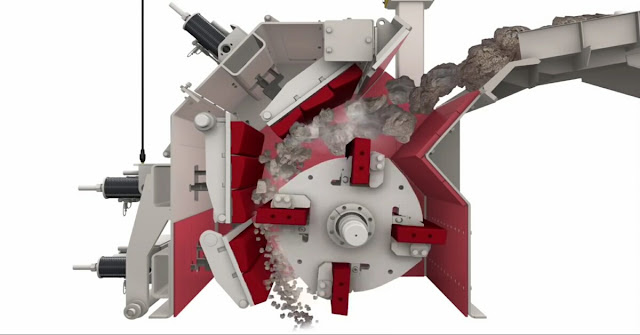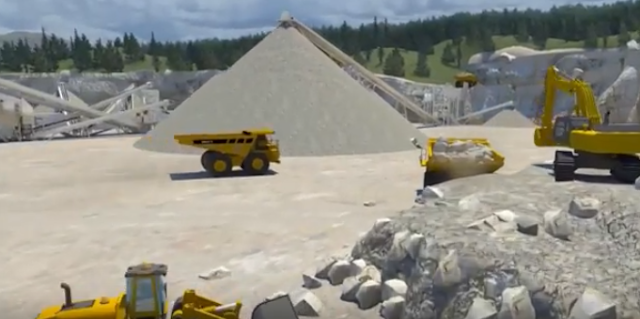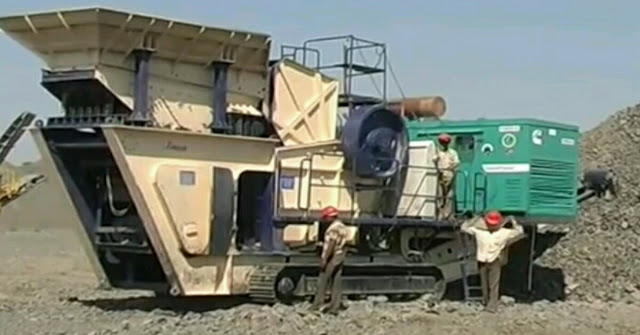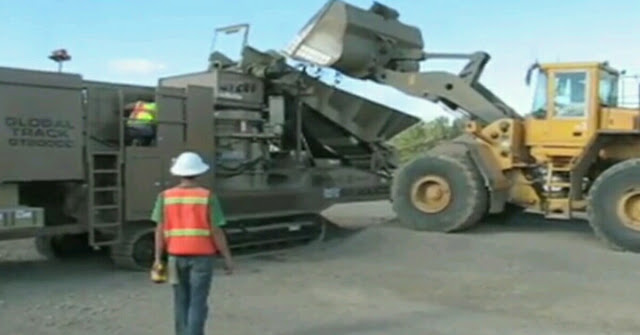Impact
09:03
The most suitable use for impact stone crusher
The impact crusher offers maximum configuration flexibility, from fine grinding to grinding, and is cost effective. It improves safety in the workplace, reduces the maintenance of quarries and provides better access to material resources. An additional advantage is that the garbage can be separated on site.
Table of contents
1. Jaw crusher, operating principle.
2. Impact crushers and hammer crushers compare advantages and disadvantages.
3. Vertical axis breaker market.
In operation, the electric motor of the impact crusher rotates the rotors at high speed. And when the hammers were installed on the rotors when the raw material was fed
classes
In operation, the electric motor of the impact crusher rotates the rotors at high speed. And since the hammers were installed on the rotors, as the materials were delivered by the impact crusher, the hammers broke the rocks or minerals under the impact function of the high-speed rotating hammers. And then the broken stones bounced off the cladding panels to get a second bruise. This treatment is continued until the required product size is delivered by the dis charger of the impact mill.
The SBM impact crusher is mainly used in the regrinding process. The crusher is specially designed for rocks and stones of medium hardness with a compressive strength of less than 350 MPa and a max. The feed size is less than 500 mm. Because of its cubic shape of the final product. The impact crusher is widely used in sand manufacturing equipment, road and rail coatings, and the water conservation industry.
The advantages
1. Hammer with high chrome plate, unique impact plate, especially for crushing hard rock, high efficiency and energy saving.
2. Low and large feed openings facilitate the organization of the production line and increase the size of the raw material.
3. Many cavities for crushing, suitable for crushing hard rock.
4. New anti-abrasive that extends the life of percussion hammer, impact plate and coating.
5. Grinding the hard stone, high efficiency and energy saving.
Application
The SBM jaw crusher is a new product that incorporates advanced technologies both at home and abroad. The impact crusher is suitable for materials with a compressive strength of less than 360 MPa and a grain size of less than 500 mm. The crusher of the company is characterized by easy maintenance, high crushing rate, grinding performance, etc.
The impact crusher of the coal production line is used in the treatment of minerals, the chemical industry, cement, building materials, flame retardants, ceramics, glass and other industries for the industry. Milling of medium-hard minerals such as limestone, quicklime, chamotte, slag, calcium salt. Sound mines, building materials, scientific articles made of coke, coal and other materials, the compressive strength of which does not exceed 150 MPa and the moisture content is less than 10%.
Advantages and disadvantages of the crusher:
Impact crusher, good grain of the material.
The wear parts of the crusher consume more than a small hammer crusher, the use of metals is high.
Spare parts for crushers are easy to replace and reduce maintenance costs.
The crusher can be a convenient and flexible adjustment of particle size, particle size, and a wide range of adjustment.
The crusher is suitable for soft materials and the hardness of very large materials.
The crusher can effectively handle the large amount of moisture in the material to prevent clogging of the crusher.
Advantages and disadvantages of the hammer crusher:
The crushing ratio of the hammer crusher is relatively small, the product contains an elongated grain form, a powder with a high grinding efficiency, low and low yield.
The hammer crusher is referred to in the work with a comparison between the crusher, the Hammersteinbrecher and the plastic in one of the following Brechmittelhärten compared to the countertop
40% savings on investment costs.
(2) A high performance of 20-30%.
3 good particle shape, less than 20-30% elongated
The "Global Market Research Report 2011-2021 on the Chinese Global Vertical Well Mill" is a detailed analysis of the current state of the vertical shaft impact mill industry focusing on the Chinese market. , The report provides in-depth knowledge of historical information, forecasts, company profiles, technologies, market factors, market trends and related parameters in the field of Vertical Axis Crushers. The report contains accurate information about the world market and the Chinese market, which would help to make better decisions and take positive steps to link them to potential micro-levels. The report covers several sectors: semiconductors, energy, pharmaceuticals, chemicals, technology, food and beverages, etc.
At the beginning of the report, a general description of the sector is proposed: definition, products, applications, technology, end-users, etc. Then the report represents the main payers of the Chinese market at the intended level. In this section, the report includes the company profile, product specification, installed capacity, latest trend, competitors' strategies, consumer product change, and market share. 2011-2016 for every company. The reports represent static data, generated revenue, production capacity, supply and demand, profits and losses, imports and exports, etc. The supplemental market is segmented by type, product, technology, end-user, application and geography depending on the requirements of competitive landscape analysis.
The report estimates the trends for the market forecast 2016-2021 for the sector of impact crushers. Our goal is to provide a thorough and accurate analysis of the various topics related to the vertical axis crusher industry. The report includes a detailed analysis of the up and down demand, market dynamics, quantitative forecasts and the future market vision. Finally, the report used a research methodology for a new project in the vertical axis crusher industry. The reports aim to meet the general customer search requirements for vertical shaft impact crushers in China and around the world 2011-2021. It covers all important parameters to gain a competitive advantage.
Table of contents
1. Jaw crusher, operating principle.
2. Impact crushers and hammer crushers compare advantages and disadvantages.
3. Vertical axis breaker market.
1.Impact coal crusher plant.
 |
| Impact coal crusher plant in accordance with the conditions in the field |
In operation, the electric motor of the impact crusher rotates the rotors at high speed. And when the hammers were installed on the rotors when the raw material was fed
classes
In operation, the electric motor of the impact crusher rotates the rotors at high speed. And since the hammers were installed on the rotors, as the materials were delivered by the impact crusher, the hammers broke the rocks or minerals under the impact function of the high-speed rotating hammers. And then the broken stones bounced off the cladding panels to get a second bruise. This treatment is continued until the required product size is delivered by the dis charger of the impact mill.
The SBM impact crusher is mainly used in the regrinding process. The crusher is specially designed for rocks and stones of medium hardness with a compressive strength of less than 350 MPa and a max. The feed size is less than 500 mm. Because of its cubic shape of the final product. The impact crusher is widely used in sand manufacturing equipment, road and rail coatings, and the water conservation industry.
The advantages
1. Hammer with high chrome plate, unique impact plate, especially for crushing hard rock, high efficiency and energy saving.
2. Low and large feed openings facilitate the organization of the production line and increase the size of the raw material.
3. Many cavities for crushing, suitable for crushing hard rock.
4. New anti-abrasive that extends the life of percussion hammer, impact plate and coating.
5. Grinding the hard stone, high efficiency and energy saving.
Application
The SBM jaw crusher is a new product that incorporates advanced technologies both at home and abroad. The impact crusher is suitable for materials with a compressive strength of less than 360 MPa and a grain size of less than 500 mm. The crusher of the company is characterized by easy maintenance, high crushing rate, grinding performance, etc.
The impact crusher of the coal production line is used in the treatment of minerals, the chemical industry, cement, building materials, flame retardants, ceramics, glass and other industries for the industry. Milling of medium-hard minerals such as limestone, quicklime, chamotte, slag, calcium salt. Sound mines, building materials, scientific articles made of coke, coal and other materials, the compressive strength of which does not exceed 150 MPa and the moisture content is less than 10%.
2.Impact crushers and hammer crushers compare advantages and disadvantages.
 |
| Adjust the use of impact stone crusher |
Impact crusher, good grain of the material.
The wear parts of the crusher consume more than a small hammer crusher, the use of metals is high.
Spare parts for crushers are easy to replace and reduce maintenance costs.
The crusher can be a convenient and flexible adjustment of particle size, particle size, and a wide range of adjustment.
The crusher is suitable for soft materials and the hardness of very large materials.
The crusher can effectively handle the large amount of moisture in the material to prevent clogging of the crusher.
Advantages and disadvantages of the hammer crusher:
The crushing ratio of the hammer crusher is relatively small, the product contains an elongated grain form, a powder with a high grinding efficiency, low and low yield.
The hammer crusher is referred to in the work with a comparison between the crusher, the Hammersteinbrecher and the plastic in one of the following Brechmittelhärten compared to the countertop
40% savings on investment costs.
(2) A high performance of 20-30%.
3 good particle shape, less than 20-30% elongated
3.Vertical axis breaker market.
 |
| China is one of the impact stone crusher manufacturers |
At the beginning of the report, a general description of the sector is proposed: definition, products, applications, technology, end-users, etc. Then the report represents the main payers of the Chinese market at the intended level. In this section, the report includes the company profile, product specification, installed capacity, latest trend, competitors' strategies, consumer product change, and market share. 2011-2016 for every company. The reports represent static data, generated revenue, production capacity, supply and demand, profits and losses, imports and exports, etc. The supplemental market is segmented by type, product, technology, end-user, application and geography depending on the requirements of competitive landscape analysis.
The report estimates the trends for the market forecast 2016-2021 for the sector of impact crushers. Our goal is to provide a thorough and accurate analysis of the various topics related to the vertical axis crusher industry. The report includes a detailed analysis of the up and down demand, market dynamics, quantitative forecasts and the future market vision. Finally, the report used a research methodology for a new project in the vertical axis crusher industry. The reports aim to meet the general customer search requirements for vertical shaft impact crushers in China and around the world 2011-2021. It covers all important parameters to gain a competitive advantage.











